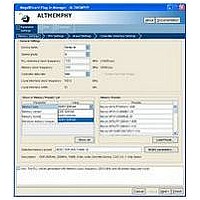IPR-HPMCII Altera, IPR-HPMCII Datasheet - Page 132

IPR-HPMCII
Manufacturer Part Number
IPR-HPMCII
Description
IP CORE Renewal Of IP-HPMCII
Manufacturer
Altera
Datasheet
1.IP-HPMCII.pdf
(176 pages)
Specifications of IPR-HPMCII
Software Application
IP CORE, Memory Controllers, SDRAM
Supported Families
Arria II GX, HardCopy III, Stratix III, Stratix IV
Core Architecture
FPGA
Core Sub-architecture
Arria, HardCopy, Stratix
Rohs Compliant
NA
Lead Free Status / RoHS Status
na
- Current page: 132 of 176
- Download datasheet (4Mb)
7–16
Table 7–5. Local Interface Signals (Part 3 of 3)
Table 7–6. CSR Interface Signals (Part 1 of 2) (Part 1 of 2)
External Memory Interface Handbook Volume 3
Section II. DDR3 SDRAM Controller with ALTMEMPHY IP User Guide
local_rdata[]
local_rdata_error
local_rdata_valid
local_ready
local_refresh_ack
local_self_rfsh_ack
local_power_down_ack
ecc_interrupt
csr_addr[]
csr_be[]
csr_wdata[]
csr_write_req
csr_read_req
csr_rdata[]
Signal Name
Signal Name
Table 7–6
Output
Output
Direction
Direction
shows the DDR3 SDRAM HPC II CSR interface signals.
Output
Output
Output
Output
Output
Output
Output
Input
Input
Input
Input
Input
Read data bus. The width of local_rdata is twice that of the memory data
bus for a full rate controller; four times the memory data bus for a half rate
controller.
Asserted if the current read data has an error. This signal is only available if
the Enable Error Detection and Correction Logic option is turned on. This
signal is asserted together with the local_rdata_valid signal.
If the controller encounters double-bit errors, no correction is made and the
controller asserts this signal.
Read data valid signal. The local_rdata_valid signal indicates that valid
data is present on the read data bus.
The local_ready signal indicates that the controller is ready to accept
request signals. If the local_ready signal is asserted in the clock cycle that
a read or write request is asserted, that request is accepted. The
local_ready signal is deasserted to indicate that the controller cannot
accept any more requests. The controller is able to buffer eight read or write
requests.
Refresh request acknowledge, which is asserted for one clock cycle every
time a refresh is issued. Even if the Enable User Auto-Refresh Controls
option is not selected, local_refresh_ack still indicates to the local
interface that the controller has just issued a refresh command.
Self refresh request acknowledge signal. This signal is asserted and
deasserted in response to the local_self_rfsh_req signal from the user.
Auto power-down acknowledge signal. This signal is asserted for one clock
cycle every time auto power-down is issued.
Interrupt signal from the ECC logic. This signal is asserted when the ECC
feature is turned on, and an error is detected. This signal remains asserted
until the user logic clears the error through the CSR interface.
Register map address.The width of csr_addr is 16 bits.
Byte-enable signal, which you use to mask off individual bytes during writes.
csr_be is active high.
Write data bus. The width of csr_wdata is 32 bits.
Write request signal. You cannot assert csr_write_req and csr_read_req
signals at the same time.
Read request signal. You cannot assert csr_read_req and
csr_write_req signals at the same time.
Read data bus. The width of csr_rdata is 32 bits.
Chapter 7: Functional Description—High-Performance Controller II
Description
Description
December 2010 Altera Corporation
Top-level Signals Description
Related parts for IPR-HPMCII
Image
Part Number
Description
Manufacturer
Datasheet
Request
R

Part Number:
Description:
IP NIOS II MEGACORE RENEW
Manufacturer:
Altera
Datasheet:

Part Number:
Description:
IP CORE Renewal Of IP-XAUIPCS
Manufacturer:
Altera
Datasheet:

Part Number:
Description:
IP CORE Renewal Of IP-10GETHERNET
Manufacturer:
Altera
Datasheet:

Part Number:
Description:
IP CORE Renewal Of IP-ASI
Manufacturer:
Altera
Datasheet:

Part Number:
Description:
IP CORE Renewal Of IP-CIC
Manufacturer:
Altera
Datasheet:

Part Number:
Description:
IP CORE Renewal Of IP-CRC
Manufacturer:
Altera
Datasheet:

Part Number:
Description:
IP CORE Renewal Of IP-ED8B10B
Manufacturer:
Altera
Datasheet:

Part Number:
Description:
CPLD, EP610 Family, ECMOS Process, 300 Gates, 16 Macro Cells, 16 Reg., 16 User I/Os, 5V Supply, 35 Speed Grade, 24DIP
Manufacturer:
Altera Corporation
Datasheet:

Part Number:
Description:
CPLD, EP610 Family, ECMOS Process, 300 Gates, 16 Macro Cells, 16 Reg., 16 User I/Os, 5V Supply, 15 Speed Grade, 24DIP
Manufacturer:
Altera Corporation
Datasheet:

Part Number:
Description:
Manufacturer:
Altera Corporation
Datasheet:










